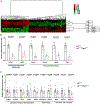RAGE/DIAPH1 and atherosclerosis through an evolving lens: Viewing the cell from the "Inside - Out"
- PMID: 39131441
- PMCID: PMC11309734
- DOI: 10.1016/j.atherosclerosis.2023.117304
RAGE/DIAPH1 and atherosclerosis through an evolving lens: Viewing the cell from the "Inside - Out"
Abstract
Background and aims: In hyperglycemia, inflammation, oxidative stress and aging, Damage Associated Molecular Patterns (DAMPs) accumulate in conditions such as atherosclerosis. Binding of DAMPs to receptors such as the receptor for advanced glycation end products (RAGE) activates signal transduction cascades that contribute to cellular stress. The cytoplasmic domain (tail) of RAGE (ctRAGE) binds to the formin Diaphanous1 (DIAPH1), which is important for RAGE signaling. This Review will detail the evidence linking the RAGE/DIAPH1 signaling pathway to atherosclerosis and envisages future therapeutic opportunities from the "inside-out" point of view in affected cells.
Methods: PubMed was searched using a variety of search terms, including "receptor for advanced glycation end products" along with various combinations including "and atherosclerosis," "soluble RAGE and atherosclerosis," "statins and RAGE," "PPAR and RAGE" and "SGLT2 inhibitor and RAGE."
Results: In non-diabetic and diabetic mice, antagonism or global deletion of Ager (the gene encoding RAGE) retards progression and accelerates regression of atherosclerosis. Global deletion of Diaph1 in mice devoid of the low density lipoprotein receptor (Ldlr) significantly attenuates atherosclerosis; mice devoid of both Diaph1 and Ldlr display significantly lower plasma and liver concentrations of cholesterol and triglyceride compared to mice devoid of Ldlr. Associations between RAGE pathway and human atherosclerosis have been identified based on relationships between plasma/serum concentrations of RAGE ligands, soluble RAGEs and atherosclerosis.
Conclusions: Efforts to target RAGE/DIAPH1 signaling through a small molecule antagonist therapeutic strategy hold promise to quell accelerated atherosclerosis in diabetes and in other forms of cardiovascular disease.
Keywords: Atherosclerosis; Diabetes; Receptor for AGE; Soluble RAGEs.
Figures






Similar articles
-
RAGE/DIAPH1 and atherosclerosis through an evolving lens: Viewing the cell from the "Inside - Out".Atherosclerosis. 2023 Sep 21:117304. doi: 10.1016/j.atherosclerosis.2023.117304. Online ahead of print. Atherosclerosis. 2023. PMID: 39492058 Review.
-
miR-214 and Its Primary Transcript Dnm3os Regulate Fibrosis and Inflammation Through RAGE Signaling in Diabetic Kidney Disease.Diabetes. 2025 Jul 1;74(7):1205-1219. doi: 10.2337/db24-0121. Diabetes. 2025. PMID: 40183805
-
Mechanistic underpinnings of AGEs-RAGE via DIAPH1 in ischemic, diabetic, and failing hearts.Am J Physiol Heart Circ Physiol. 2025 Mar 25:10.1152/ajpheart.00685.2024. doi: 10.1152/ajpheart.00685.2024. Online ahead of print. Am J Physiol Heart Circ Physiol. 2025. PMID: 40132210 Free PMC article.
-
The Role of Advanced Glycation End-Products in the Pathophysiology and Pharmacotherapy of Cardiovascular Disease.Int J Mol Sci. 2025 Jul 29;26(15):7311. doi: 10.3390/ijms26157311. Int J Mol Sci. 2025. PMID: 40806443 Free PMC article. Review.
-
Deletion of the formin Diaph1 protects from structural and functional abnormalities in the murine diabetic kidney.Am J Physiol Renal Physiol. 2018 Dec 1;315(6):F1601-F1612. doi: 10.1152/ajprenal.00075.2018. Epub 2018 Aug 22. Am J Physiol Renal Physiol. 2018. PMID: 30132346 Free PMC article.
Cited by
-
Pathological role of RAGE underlying progression of various diseases: its potential as biomarker and therapeutic target.Naunyn Schmiedebergs Arch Pharmacol. 2025 Apr;398(4):3467-3487. doi: 10.1007/s00210-024-03595-6. Epub 2024 Nov 26. Naunyn Schmiedebergs Arch Pharmacol. 2025. PMID: 39589529 Review.
References
Publication types
MeSH terms
Substances
Grants and funding
LinkOut - more resources
Full Text Sources
Medical

